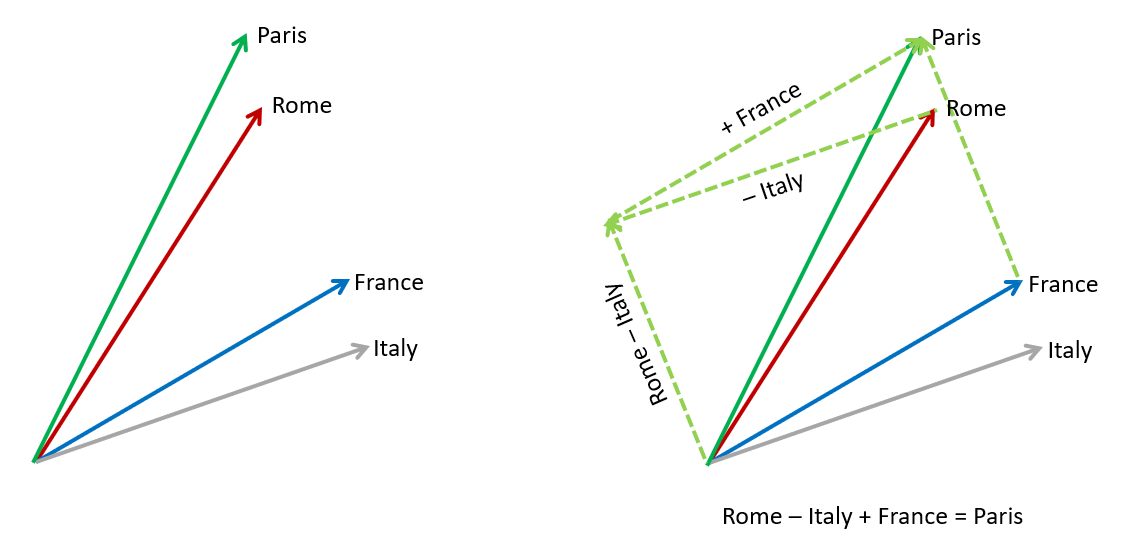Arithmetic Operators
Addition, subtraction, and multiplication can be applied to vectors dimension-wise in SQL and PL/SQL.
Addition
Vector addition is often used in Natural Language Processing (NLP) where words are often represented as vectors that capture their meaning in a numerical format. Vector addition is used to combine these meanings and understand relationships between words, a task also referred to as word analogy.
Given two vectors A=(a1, a2, a3) and B=(b1, b2,
b3), C = A + B is computed as C = (a1+b1, a2+b2,
a3+b3).
Subtraction
Vector subtraction can be used in word analogy scenarios but is also useful in the context of facial recognition. Each face can be represented by a vector of facial features (distance between eyes, eye color, and so on). Subtracting one vector from another gives you the main differences between the two faces, giving you the information needed to recognize whether they are similar or not.
Given two vectors A=(a1, a2, a3) and B=(b1, b2,
b3), C = A - B is computed as C = (a1-b1, a2-b2,
a3-b3).
Multiplication
Vector multiplication of each corresponding coordinate of two vectors, or element-wise product, is called the Hadamard product. The Hadamard product is often used in neural networks and computer vision.
Given two vectors A=(a1, a2, a3) and B=(b1, b2,
b3), the Hadamard product A*B is computed as A*B =
(a1*b1, a2*b2, a3*b3).
Semantics
Both sides of the operation must evaluate to vectors with matching
dimensions and must not be BINARY or SPARSE
vectors. The resulting vector has the same number of dimensions as the operands and
the format is determined based on the formats of the inputs. If one side of the
operation is not a vector, an attempt is made automatically to convert the value to
a vector. If the conversion fails, an error is raised.
The format used for the result is ranked in the following order:
flexible, FLOAT64, FLOAT32, then
INT8. As in, if either side of the operation has a flexible
format, the result will be flexible, otherwise, if either side has the format
FLOAT64, the result will be FLOAT64, and so
on.
Consider two vectors with the following values:
v1 = [1, 2, 3]
v2 = [10, 20, 30]v1 and v2 would, for
example, result in the following:
v1 + v2is[11, 22, 33]v1 - v2is[-9, -18, -27]v1 * v2is[10, 40, 90]v1 + NULLisNULL
If either side of the arithmetic operation is NULL, the
result is NULL. In the case of dimension overflow, an error is
raised. For example, adding VECTOR('[1, 127]', 2, INT8) to
VECTOR('[1, 1]', 2, INT8) results in an error because
127+1=128, which overflows the INT8
format.
The use of division operators on vectors is not supported.
Examples
Word Analogy
Using word embeddings, suppose you want to find the relationship between "Rome" and "Paris". You can take the vector for "Rome", subtract the vector for "Italy", and then add the vector for "France". This results in a new vector that approximates the meaning of the word "Paris". The calculation should be "Rome - Italy + France = Paris" using an ideal embedding model.
Basic Vector Arithmetic
SELECT VECTOR('[5, 10, 15]') - VECTOR('[2, 4, 6]');
VECTOR('[5,10,15]')-VECTOR('[2,4,6]')
------------------------------------------------------------
[3.0E+000,6.0E+000,9.0E+000]
SELECT VECTOR('[1, 2, 3]', 3, FLOAT64) + VECTOR('[4, 5, 6]', 3, FLOAT32) * '[2, 2, 2]';
VECTOR('[1,2,3]',3,FLOAT64)+VECTOR('[4,5,6]',3,FLOAT32)*'[2,2,2]'
--------------------------------------------------------------------------------
[9.0E+000,1.2E+001,1.5E+001]DECLARE
v1 VECTOR := VECTOR('[10, 20, 30]', 3, INT8);
v2 VECTOR := VECTOR('[6, 4, 2]', 3, INT8);
BEGIN
DBMS_OUTPUT.PUT_LINE(TO_CHAR(v1 + v2));
DBMS_OUTPUT.PUT_LINE(TO_CHAR(v1 - v2));
DBMS_OUTPUT.PUT_LINE(TO_CHAR(v1 * v2));
END;
/Result:
[16,24,32]
[4,16,28]
[60,80,60]